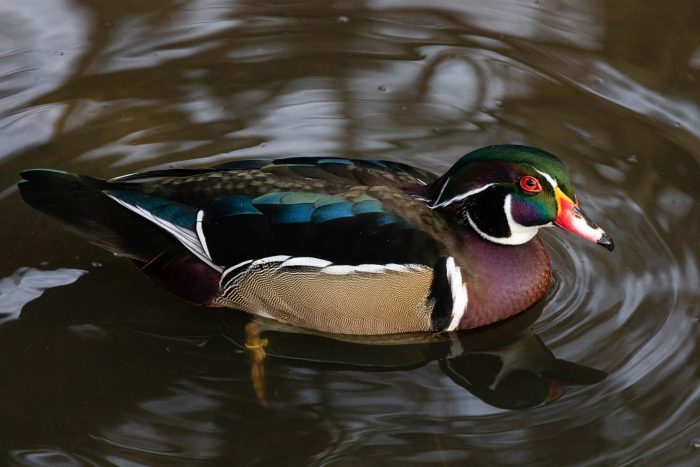Wood Duck
Aix sponsa
The wood duck is a beautifully colored dabbling duck with a green head, red eyes and white stripes on the head and body. It lives in the Chesapeake Bay region's freshwater wetlands and streams from spring through autumn.
This section shows one large critter image at a time. Use the thumbnails that follow to select a specific image to display here.

This gallery contains a grid of small thumbnails. Selecting a thumbnail will change the main image in the preceding section.
Appearance
The wood duck has a long, squared tail and a sharp bill and claws. Males and females have different patterns and coloring. Males (drakes) have a distinctive head patterned with white stripes and iridescent green and purple patches. They also have red eyes, a reddish-orange bill, a chestnut breast and a swept-back crest on the back of their head. Females (hens) are dull, mottled brown with a white eye patch and a short crest. Juveniles look similar to adult females. Wood ducks grow to 20 inches in length with a wingspan of about 28 inches.
Feeding
The wood duck feeds on seeds from trees, wetland plants and bay grasses, including oak acorns, wild rice and pondweeds. It also eats insects and small invertebrates. It will usually find its food on the water’s surface, but may “tip up” its tail and submerge its head to reach food underwater.
Predators
Humans hunt wood ducks. Owls, raccoons, red foxes and black rat snakes prey upon wood ducklings.
Flight
A wood duck can be identified in flight by its white belly and long, squared tail.
Voice
Adults have 12 calls, while young can make up to five calls. Males commonly make a whistle that sounds like hoo-w-eek. Females have special calls to locate their mate and to warn their young when predators are near.
Reproduction and life cycle
Wood ducks nest in March to April in tree cavities and man-made nesting boxes. Females line their nests with feathers and debris. Nests are located no more than a mile from water. Females lay 9 to 12 eggs, which hatch in about one month.
Within 24 hours of hatching, ducklings climb out of the nest and fall to the ground. The female then leads her ducklings to the nearest water body. Nearly 90 percent of wood ducklings die within the first two weeks, mostly due to predation. The female protects her young until they are able to fly, about 60 days after hatching. Wood ducks usually live 3 to 4 years but can live as long as 15 years.
Did you know?
- Wood ducks are the only dabbling ducks in the Chesapeake region to nest in tree cavities.
- Aix sponsa, the wood duck’s scientific name, translates to “waterfowl in a bridal dress.”
- Wood ducks nearly went extinct in the early 1900s due to hunting and habitat loss. Hunting regulations and a popular program to put man-made nesting boxes in wood duck nesting areas helped them recover.
Sources and additional information
- Life in the Chesapeake Bay by Alice Jane Lippson and Robert L. Lippson
- Chesapeake Bay: Nature of the Estuary, A Field Guide by Christopher P. White
- Animal Diversity Web: Aix sponsa – University of Michigan Museum of Zoology
- Waterfowl ID: Wood Duck – Ducks Unlimited
- All About Birds: Wood Duck – The Cornell Lab of Ornithology
